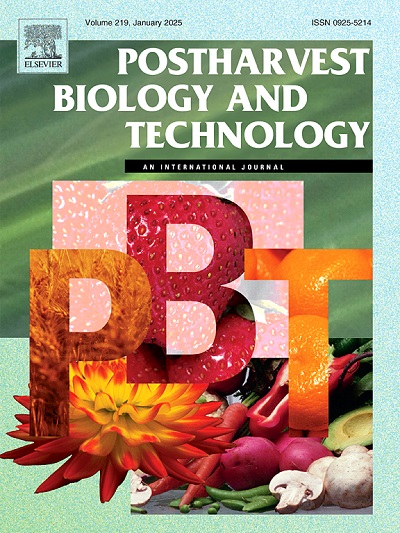Moisture state and volatile flavor behavior characterization of Naematelia aurantialba during postharvest in modified atmosphere packaging storage after treated with ultraviolet radiation C
IF 6.4
1区 农林科学
Q1 AGRONOMY
引用次数: 0
Abstract
Naematelia aurantialba (N. aurantialba), a rare edible mushroom, is valued for its unique texture, rich flavor, and abundant bioactive compounds, including polysaccharides and carotenoids. However, its exceptionally high moisture content makes it highly perishable, leading to rapid quality deterioration, water loss, and undesirable flavor changes during storage. In our previous study, we established the optimal composite storage conditions for N. aurantialba, where 0.19 kJ/m2 ultraviolet C (UVC) irradiation was applied under modified atmosphere packaging (MAP) conditions (oxygen permeability: 4081 mL m-² d−1 atm−1) to effectively maintain postharvest quality. This study builds upon those findings by investigating the effects of UVC treatment on moisture migration and volatile compounds in N. aurantialba, comparing the UVC-treated group with a non-UVC control group. Low-field nuclear magnetic resonance (LF NMR), magnetic resonance imaging (MRI), gas chromatography-mass spectrometry (GC-MS), and an electronic nose (E-Nose) were employed to analyze water migration and volatile compound dynamics. The results indicated that UVC treatment significantly slowed free water migration, reduced moisture loss (2.46 ± 0.37 % at the end of storage), enhanced key flavor compounds such as alcohols and esters, and inhibited undesirable odors. Sensory evaluations confirmed improvements in flavor, texture, and overall acceptability. These findings provide new insights into the physiological responses of N. aurantialba to UVC treatment, offering a scientific basis for optimizing postharvest storage strategies and improving quality retention in high-moisture edible fungi.
紫外辐射C处理后金缕梅采后气调包装贮藏水分状态及挥发性风味行为表征
aurantialba Naematelia aurantialba (N. aurantialba)是一种罕见的食用菌,因其独特的质地、浓郁的风味和丰富的生物活性成分(包括多糖和类胡萝卜素)而受到重视。然而,其极高的水分含量使其极易腐烂,导致质量迅速恶化,水分流失,并在储存过程中产生不良的风味变化。在之前的研究中,我们建立了最佳的aurantialba复合贮藏条件,在改良气氛包装(MAP)条件下(氧透性:4081 mL m-²d−1 atm−1),施加0.19 kJ/m2紫外线C (UVC)照射,有效地保持了aurantialba的采后品质。本研究是在这些发现的基础上,通过研究UVC处理对金缕兰水分迁移和挥发性化合物的影响,并将UVC处理组与非UVC对照组进行比较。采用低场核磁共振(LF NMR)、磁共振成像(MRI)、气相色谱-质谱联用(GC-MS)和电子鼻(E-Nose)分析了水迁移和挥发性化合物动力学。结果表明,UVC处理显著减缓了自由水分迁移,降低了水分损失(贮藏结束时为2.46 ± 0.37 %),增强了关键风味化合物(如醇类和酯类),抑制了不良气味。感官评价证实了味道、质地和整体可接受性的改善。这些研究结果为了解紫花金巴对UVC处理的生理反应提供了新的认识,为优化高水分食用菌采后贮藏策略和提高品质保存率提供了科学依据。
本文章由计算机程序翻译,如有差异,请以英文原文为准。
求助全文
约1分钟内获得全文
求助全文
来源期刊

Postharvest Biology and Technology
农林科学-农艺学
CiteScore
12.00
自引率
11.40%
发文量
309
审稿时长
38 days
期刊介绍:
The journal is devoted exclusively to the publication of original papers, review articles and frontiers articles on biological and technological postharvest research. This includes the areas of postharvest storage, treatments and underpinning mechanisms, quality evaluation, packaging, handling and distribution of fresh horticultural crops including fruit, vegetables, flowers and nuts, but excluding grains, seeds and forages.
Papers reporting novel insights from fundamental and interdisciplinary research will be particularly encouraged. These disciplines include systems biology, bioinformatics, entomology, plant physiology, plant pathology, (bio)chemistry, engineering, modelling, and technologies for nondestructive testing.
Manuscripts on fresh food crops that will be further processed after postharvest storage, or on food processes beyond refrigeration, packaging and minimal processing will not be considered.
 求助内容:
求助内容: 应助结果提醒方式:
应助结果提醒方式:


